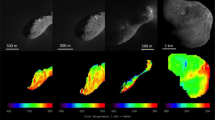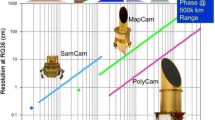Abstract
This paper describes the collection, reduction, and analysis of 0.4–1.0 μm Mars imaging spectroscopy data obtained during the 1988 and 1990 oppositions from Mauna Kea Observatory and provides a general outline for the acquisition and analysis of similar imaging spectroscopy data sets. The U.H. 2.24-m Wide Field Grism CCD Spectrograph was used to collect 13 three-dimensional image cubes covering 90% of the planet south of 50°N in the 0.4–0.8 μm region (λ/Δλ=245 at 0.6 μm) and covering 55% of the planet south of 50°N in the 0.5–1.0 μm region (λ/Δλ=293 at 0.75 μm). Spectra extracted from these image cubes reveal the detailed character of the martian near-UV to visible spectrum. Images at red wavelengths reveal the “classical” albedo markings at 100–500 km spatial resolution while images at blue wavelengths show little surface feature contrast and are dominated by condensate clouds/hazes and polar ice. Many of the data acquisition, reduction, and analysis steps discussed here are new or unique to imaging spectroscopy data sets. These techniques exploit the information contained within the spatial domain of data such as these, thus allowing more traditional point-spectral analysis techniques to be expanded into an imaging format.
Similar content being viewed by others
References
AdamsJ.B., SmithM.O., and JohnsonP.E. (1986) Spectral mixture modeling: A new analysis of rock and soil types at the Viking Lander I site.J. Geophys. Res., 91, 8098–8112.
ArvidsonR.E., GuinnessE.A. and ZentA.P. (1982) Classification of surface units in the equatorial region of Mars based on Viking Orbiter color, albedo, and thermal data.J. Geophys. Res., 87, 10149–10157.
Bell J.F. III (1992a)The Ferric Mineralogy of Mars. Ph.D. Dissertation, University of Hawaii at Manoa, 236 pp.
Bell J.F. III (1992b) Charge-Coupled Device Imaging Spectroscopy of Mars. 2. Results and Implications for Martian Ferric Mineralogy. Submitted toIcarus.
BellJ.F.III and McCordT.B. (1989) Mars: Near-infrared comparative spectroscopy during the 1986 opposition.Icarus, 77, 21–34.
BellJ.F.III, McCordT.B., and OwensbyP.D. (1990a) Observational evidence of crystalline iron oxides on Mars.J. Geophys. Res., 95, 14447–14461.
Bell J.F. III, McCord T.B., and Lucey P.G. (1990b) Imaging spectroscopy of Mars (0.4–1.1 μm) during the 1988 opposition.Proc. Lunar Planet. Sci. Conf. 20th, 479–486.
BinderA.B. and JonesJ.C. (1972) Spectrophotometric studies of the photometric function, composition, and distribution of the surface materials of Mars.J. Geophys. Res., 77, 3005–3020.
ChavezP.S. and KwartengA.Y. (1984) Extracting spectral contrast in Landsat Thematic Mapper image data using selective principal components analysis.Photogramm. Eng. and Rem. Sens., 55, 339–348.
ClarkR.N. and T.L.Roush (1984)Reflectance spectroscopy: Quantitative analysis techniques for remote sensing applications.J. Geophys. Res., 89, 6329–6240.
ClarkR.N., KingT.V.V., KlejwaM., SwayzeG., and VergoN. (1990) High spectral resolution reflectance spectroscopy of minerals.J. Geophys. Res., 95, 12653–12680.
DavisJ.C. (1986)Statistics and Data Analysis in Geology, John Wiley and Sons Pubs., New York, pp. 527–546.
JohnsonH.L., MitchellR.I., IriarteB., and WiśniewskiW.Z. (1966) UBVRIJKL photometry of the bright stars,Comm. Lunar Planet. Lab, 4, 2–110.
Kuiper G.P. (1952) Planetary atmospheres and their origin, inThe Atmospheres of the Earth and Planets, pp. 306–405 (Kuiper, G.P. ed.), Univ. of Chicago Press.
LangK.R. (1978)Astrophysical Formulae, p. 175, Springer-Verlag Inc., New York.
LoughlinW.P. (1991) Principal component analysis for alteration mapping,Photogramm. Eng. Rem. Sens., 57, 1163–1169.
LuceyP.G., BrunoB.C., and HawkeB.R. (1989) Imaging spectroscopy of the Humorum Basin of the Moon (abstract).Bull. Amer. Astron. Soc., 21, 971.
Lucey P.G., Bruno B.C., and Hawke B.R. (1991) Preliminary results of imaging spectroscopy of the Humorum Basin region of the Moon.Proc. Lunar Planet. Sci. Conf. 21st, 391–403.
McCordT.B. (1968) A double beam astronomical photometer.Appl. Optics, 7, 475–478.
McCordT.B. and AdamsJ.B. (1969) Spectral reflectivity of Mars.Science, 163, 1058–1060.
McCordT.B. and WestphalJ.A. (1971) Mars: Narrowband photometry, from 0.3 to 2.5 microns, of surface regions during the 1969 apparition.Astrophys. J., 168, 141–153.
McCordT.B., HugueninR.L., MinkD., and PietersC. (1977a) Spectral reflectance of martian areas during the 1973 opposition: Photoelectric filter photometry, 0.33–1.10 μm.Icarus, 31, 25–39.
McCordT.B., HugueninR.L. and JohnsonG.L. (1977b) Photometric imaging of Mars during the 1973 opposition.Icarus, 31, 293–314.
McCordT.B., ClarkR.N., and HugueninR.L. (1978) Mars: Near-infrared spectral reflectance and compositional implications.J. Geophys. Res., 83, 5433–5441.
McCordT.B., SingerR.B., HawkeB.R., AdamsJ.B., EvansD.L., HeadJ.W., Mouginis-MarkP.J., PietersC.M., HugueninR.L., and ZiskS.H. (1982) Mars: Definition and characterization of global surface units with emphasis on composition.J. Geophys. Res., 87, 10129–10148.
MorrisR.V., LauerH.V.Jr., LawsonC.A., GibsonE.K.Jr., NaceG.A., and StewartC. (1985) Spectral and other physicochemical properties of submicron powders of hematite (α-Fe2O3), maghemite (γ-Fe2O3), magnetite (Fe3O4), goethite (α-FeOOH), and lepidocrocite (γ-FeOOH),J. Geophys. Res., 90, 3126–3144.
Paige D.A. and Keegan K.D. (1991) Thermal and albedo mapping of the south polar region of Mars (abstract)Lunar and Planetary Science XXII, 1013–1014.
PalluconiF.D. and KiefferH.H. (1981) Thermal inertia mapping of Mars from 60° S to 60° N.Icarus, 45, 415–426.
Possolo A., Adams J.B., and Smith M.O. (1992) Mixture models for multispectral images, submitted toJ. Geophys. Res.
SiegalB.S. and GillespieA.R. (1980)Remote Sensing in Geology, John Wiley and Sons Pub., New York, 200 pp.
SingerR.B., MillerJ.S., WellsW.K., and BusE.S. (1990) Visible and near-IR spectral imaging of Mars during the 1988 opposition (abstract).Lunar and Planetary Sci. XXI, pp. 1164–1165 (Lunar and Planetary Institute, Houston, TX).
SnyderJ.P. (1982)Map Projections Used by the U.S. Geological Survey. U.S.G.S. Bulletin 1532, U.S. Govt. Printing Office, Washington D.C., 313 pp.
Author information
Authors and Affiliations
Rights and permissions
About this article
Cite this article
Bell, J.F., Lucey, P.G. & McCord, T.B. Charge-coupled device imaging spectroscopy of Mars. 1. Instrumentation and data reduction/analysis procedures. Exp Astron 2, 287–306 (1992). https://doi.org/10.1007/BF00690087
Received:
Accepted:
Issue Date:
DOI: https://doi.org/10.1007/BF00690087




